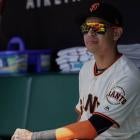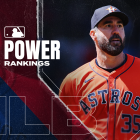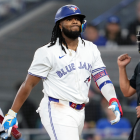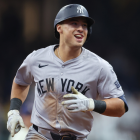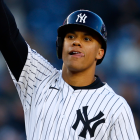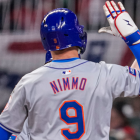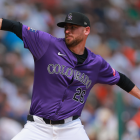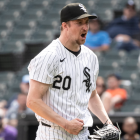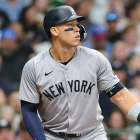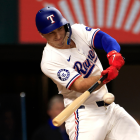With the start of spring training upon us, it's time to prepare for real baseball games. That means, among other things, figuring out which of the youngsters who help fill out the early spring rosters could end up contributing later this season.
Note that we've pulled these reports from our team prospect lists, the full set of which you can access by clicking here. Within, you'll find each team's top five prospects, as well as five others worth knowing for various reasons. The players included here are the so-called "2020 contributors" in each system -- the players who, for whatever reason, are likely to play a role this season.
For those who are only concerned about the best of the best, be sure to check our top-50 list by clicking here.
| | |
| Jon Duplantier made 15 big-league appearances, but remains a "prospect" because most were relief appearances lasting three innings or fewer. Duplantier's durability has always made him a candidate to move to the bullpen full time, so it's possible this is a glimpse of his future. The Diamondbacks would probably request that -- if it is -- he finds a way to miss more bats with his slider, which was thought to be a plus pitch entering last season, as he ranked 354rd (out of 374) in whiffs-per-swing. Should Duplantier do that, he should become a quality reliever. | |
| | |
| Patrick Weigel is a large lad who missed most of the 2018 season after undergoing Tommy John surgery. He has a big-time fastball and solid secondaries, but struggled with his command -- perhaps not a surprise, given his delivery. Weigel will likely land in the bullpen, where he could contribute at the big-league level as soon as the 2020 season. | |
| | |
| Ryan Mountcastle is 22 years old and coming off a season in which he batted .312 with 25 home runs in Triple-A. Why isn't he in the top five for the O's? (Heck, why isn't he in the majors?) Because his game features significant holes, beginning with his defense. Originally a shortstop-turned-third baseman, Mountcastle is now a first baseman/left fielder. The pressure isn't so much on his bat as it is conjoined to his bat like melted candy. That would seem like a good thing -- see his numbers this season -- except … Mountcastle is swing-happy and prone to zone expansion, resulting in a strikeout-to-walk ratio exceeding 5.40. All he's done is hit throughout his professional career, and there's a chance he continues to do so. There's also a chance he doesn't, and that he becomes just the second- or third-best of his kind on the Orioles' 25-player roster. | |
| | |
| Tanner Houck -- pronounced "Hawk," for those wondering -- was a first-round pick in 2017 whose mechanics resemble a right-handed Chris Sale -- down to the high elbow during his arm stroke, the low release point, and the crossfire action. He doesn't have the rest of Sale's package, however, and is therefore unlikely to join him in the rotation. Houck seems better suited for the bullpen, where his unsteady changeup can be shelved and he can torment same-handed batters. That's how he was used in Triple-A and it's probably wise to bet on him being deployed in a similar manner for the big-league team sometime during the 2020 season. | |
| | |
| Robel Garcia has a lovely story that includes playing in Italy for several seasons. He resurfaced with the Cubs organization this year, and did enough to earn a 31-game cameo in the majors, where he homered five times (giving him 32 overall). Garcia is a switch-hitter who can play all over, and -- well, this sounds like a useful bench bat, but there is a catch. Garcia is highly prone to swinging and missing and striking out, to the extent that he whiffed on 45 percent of his big-league swings -- including more than 60 percent of his swings taken on non-fastballs. Until he proves that he isn't as exploitable as he appears, he's going to carry a high risk factor. | |
| | |
| Codi Heuer is a crossfire slinger who saw his strikeout rate drop once he moved up to Double-A. He gets the nod here due to romanticism: who doesn't yearn for the groundball specialist to return? Heuer, for his part, could someday play the part. He coerced more than 60 percent grounders in 2019, per FanGraphs, and didn't yield a home run in 67 innings. He should open the season in the high minors, but could finish it in Chicago. | |
| | |
| Vladimir Gutierrez spent the 2019 season in Triple-A, where he was awfully homer-prone. Yes, the altered baseball caused mayhem across the land, but he had the third-highest homer rate on his team among the 11 pitchers with 40-plus frames. That's concerning. Gutierrez is on the shorter side and he struggled with lefties last year (though he dominated them in 2018), both of which could lead to him landing in the bullpen. If that happens, his fastball-breaking ball combination could make him an asset. Either way, expect him to debut in 2020. | |
| | |
| One of the pieces Cleveland gained in the Yasiel Puig-Trevor Bauer three-team trade, Logan Allen is a physical southpaw with an uptempo delivery who has already pitched in the majors. Allen has a deep if not particularly outstanding arsenal, beginning with a low-90s sinker and extending to a good changeup, a slider, and a get-me-over curveball. He profiles as a mid-rotation type and should receive ample opportunity as soon as springtime. | |
| | |
| Sam Hilliard made slow and steady progress through the Rockies system since being picked in the 15th round in 2015. In fact, up until 2019 he'd played at only one level per year. That changed last season, as he was rewarded with his first big-league cameo after homering 35 times in 126 Triple-A games. Hilliard has good pop, obviously, as well as good speed and a patient approach. He might just be a platoon outfielder, but he's ready for action now. | |
| | |
| Yet another member of Detroit's Double-A rotation, Alex Faedo has a good slider and he posted a 5.36 strikeout-to-walk ratio in 22 starts. He's a short-strider with a shallow release point, however, which causes his stuff to play down. To wit, he permitted three more home runs (17) in 115 innings than Mize, Manning, and Skubal yielded in 254 innings combined. Faedo should reach the majors in 2020, though he may end up in the bullpen as the new Chaz Roe. | |
| | |
| Garrett Stubbs has been featured on these lists since approximately the beginning of time, give or take a few years. The knock on him remains the same: He's on the smaller side, which has presumably contributed to a rash of durability woes. Including 2019, Stubbs has yet to tally as many as 400 plate appearances in a season. He's normally productive when he plays, yet it might be in his best interest to branch out and try other positions -- not so he can move off catcher completely, but so that he can stick in the lineup without taking the beating catching necessitates. | |
| | |
| Tricky southpaw Richard Lovelady debuted last season, gracing 25 games with his presence and posting some poor numbers following a rough finish. (In his final seven appearances he completed 5 ⅓ innings and yielded 10 runs on 13 hits.) Lovelady throws across his body from a sidearm slot, and profiles as at least a left-handed specialist thanks to a pair of average or better pitches: a low-to-mid-90s sinker and a slider. He's on the 40-player roster and already has 70 Triple-A appearances under his belt, so he should crack the Opening Day bullpen. | |
| | |
| Michael Hermosillo has received a scattering of plate appearances in the Show in each of the past two seasons. He hasn't shown much in them, but there's reason to think he can become a spare outfielder. He runs well and has a good eye at the plate. The catch is that swing-and-miss prevalent in Hermosillo's game might prevent him from fulfilling his promise. It's worth noting he flattened his bat more last season as part of his load -- presumably to improve his contact rate. That fix didn't seem to work, so he'll have to go back to the drawing board this winter. | |
| | |
| DJ Peters is a fascinating prospect: a 6-foot-6, 225-pounder with big-time raw power and enough arm and speed to convince the Dodgers to play him mostly in center field. The catch is that he's prone to striking out. A lot. He's fanned at least 30 percent of the time in every season since he reached A-ball, and that doesn't seem likely to change -- not now, perhaps never. Peters hit .260/.388/.490 in 57 Triple-A games and will require protection from the Rule 5 draft this winter, suggesting his big-league debut will occur within a year. (Note: Jeter Downs, since traded to the Red Sox, was originally the Dodgers' 2020 contributor.) | |
| | |
| A piece of the Dee Gordon trade, Nick Neidert likely would have debuted in 2019 were it not for a knee operation that cost him part of his season. He's a command-and-changeup right-hander with a short arm stroke -- similar to Joe Kelly or Lucas Giolito -- who is going to have to prove his so-so arsenal can play against big-league hitters before anyone regards him as more than a back-end option. He should get a look early on. | |
| | |
| Drew Rasmussen is a shorter right-hander who has already undergone a pair of Tommy John surgeries. There is, in other words, no reason to play it slow and low with him. The Brewers haven't, enabling him to reach Double-A in his first full professional season. Although Rasmussen was technically a starter for most of the year, the Brewers limited him to fewer than four innings in 23 of his 27 appearances. It's possible they envision using him in a similar role in the future -- think along the lines of an opener, except perhaps one time through the order -- in which his fastball and breaking ball would benefit from shorter spurts, and so would his body. | |
| | |
| Brent Rooker likely would have debuted in 2019 during one of Nelson Cruz's absences were it not for his own injury woes. He was limited to just 281 plate appearances all of last season, and in those he hit .282/.399/.530 with 14 home runs. Rooker is essentially a one-trick pony, but that trick -- hitting for power -- tends to go a long way. The Baltimore Orioles seem to have a monopoly on this type, so maybe he'll end up with them someday down the road. Until then, Rooker will try to overcome his obvious limitations and latch on with the Twins as a bench bat. | |
| | |
| Historically a contact manager, David Peterson did strike out more than a batter per nine in Double-A last season. Even so, Peterson projects as a No. 4 type without swing-and-miss stuff. There's value in that -- particularly if his groundball percentage translates to the highest level -- but no one should have illusions about him becoming the Mets' next homegrown ace. | |
| | |
| Originally acquired as part of the Garrett Cooper trade, Michael King made his big-league debut last season, throwing two innings in a late-September appearance. King's game is built on the deception he gains from a crossfire delivery, as he comes up short in terms of raw stuff -- his sinker, for instance, clocks in around 92 mph. He does command his pitches well, and there's some precedent for this type outperforming their so-so raw stuff. King should get the opportunity to strut his stuff at the big-league level throughout the upcoming season. | |
| | |
| Originally acquired in the Sonny Gray deal, Jorge Mateo has had an up-and-down career. He was up again in 2019, nearly posting his first 20-20 season while hitting .289/.330/.504 at Triple-A. (Do note that Oakland's Triple-A affiliate had an OPS over .900 as a team.) Mateo's approach is likely to yield some ugly walk-to-strikeout ratios in the majors, putting pressure on his ability to leverage his top-of-the-scale speed into hustle extra-base hits. He's out of options and will presumably open the season on someone's bench. (Insert your own joke here about "someone" being the Kansas City Royals.) | |
| | |
| Acquired in exchange for Freddy Galvis in 2017, Enyel De Los Santos made his first big-league appearances in 2018 and returned to the scene for five more in 2019. He has a good fastball-changeup combination, but his breaking balls and delivery are substandard and will likely limit him to a career in relief. It's not all bad for De Los Santos: he's likely to make more big-league appearances in 2020. | |
| | |
| Technically, Kevin Kramer has already played in the majors; he just hasn't done much with his opportunities. That may continue. Kramer is a so-so defender whose best position is second base because he doesn't throw or run well (his sprint speed was in the 24th percentile). In other words, he needs to hit to sit on a big-league bench. Kramer is so prone to the strikeout that there's no guarantee he does. There's some pop here, so the Pirates should (and presumably will) give him more time to prove whether he's worth keeping or a future waivers fixture. | |
| | |
| Adrian Morejon made five appearances in the majors before being shut down with a shoulder impingement in August. Staying on the mound has been a challenge for him, as he's yet to throw more than 65 innings in a season. Factor in his build -- he's strong but on the short side -- and there's a chance he winds up being pushed to the bullpen. Morejon won't turn 21 until late February, so expect the Padres to give him and his three-pitch mix another look as a starter. | |
| | |
| Acquired at the deadline in exchange for Drew Pomeranz and Ray Black, Mauricio Dubon has a chance of being the Giants' most-days second baseman in 2020. He's a free-swinger who isn't likely to walk much, yet he has a good feel for contact and shows some mindfulness about his craft by varying his stride -- often leg-kicking, but sometimes going with a toe-tap instead. At minimum, Dubon should be a useful spare infielder who is already big-league-ready. | |
| | |
| The Mariners had 42 different players pitch for them in 2019, including 24 in a relief capacity. None of them were Joey Gerber, but he figures to make his big-league debut in 2020. Gerber has a high-grade fastball and an above-average slider and pitches from a low three-quarters slot, making baby food out of right-handed batters -- he held them to a .548 OPS last season. Do note: he struck out more than a third of the hitters he saw between High- and Double-A. | |
| | |
| Junior Fernandez threw 11 innings in the majors last season, showing legitimate bat-missing potential thanks to a mid-to-upper 90s fastball, a good changeup, and a slider that always lagged behind his other offerings. Fernandez still struggles with his command, but figures to spend more time in the majors in 2020 -- and could find himself with a high-leverage role if he can smooth out his wrinkles a little more. | |
| | |
| Originally an undrafted free agent, right-hander Tyler Zombro doesn't scream pitcher of note -- if anything, he looks like a piece of organizational depth due to his lackluster velocity and a recently passed 25th birthday. Yet Zombro's low arm slot creates a lot of deception, and helps generate good movement on his pitches. The Rays had him throw multiple innings in roughly half of his 41 outings last season, suggesting they might use him in a similar role in the majors. Don't be surprised if Zombro ends up in the Show before 2020 is out. | |
| | |
| Like Solak, Brock Burke was acquired from the Rays over the past year. Unlike Solak, Burke's introduction to the majors went poorly. Billed as a four-pitch southpaw with two potential plus secondaries, he struggled to miss bats -- to the extent that his 13.1 percent whiff rate was the third-lowest among pitchers with at least 100 batters faced, per Statcast, ahead of only Erc Skoglund and Dan Otero. That's not ideal. Burke's game score also declined in each of his final five starts. That, too, is not ideal. Oh, and he missed time with a shoulder impingement. You get the bit by now. Anyway, he should get more of a look in 2020. | |
| | |
| Anthony Kay, part of the return on Marcus Stroman, has already appeared in the majors despite making just 49 minor-league starts to date. He's a three-pitch lefty -- fastball, changeup, curveball -- who may not have a plus offering at his disposal. Historically a flyball pitcher, it's least worth wondering if Kay will miss enough bats and barrels to become more than a back-end starter in the majors. The Blue Jays owe it to themselves to find out, so expect Kay to receive ample opportunity in 2020 and beyond. | |
| | |
| Right-handed reliever James Bourque has already pitched in the majors, having faced six batters in his May debut. He has the potential for two quality offerings, including a mid-to-upper 90s fastball, but there is some reason for reservation. Foremost, he has below-average command. On top of that, it's perhaps not a great sign that the Nationals didn't ask him to make more appearances over the remainder of the season, given the state of their bullpen. He'll presumably get more of an opportunity in 2020. | |











































